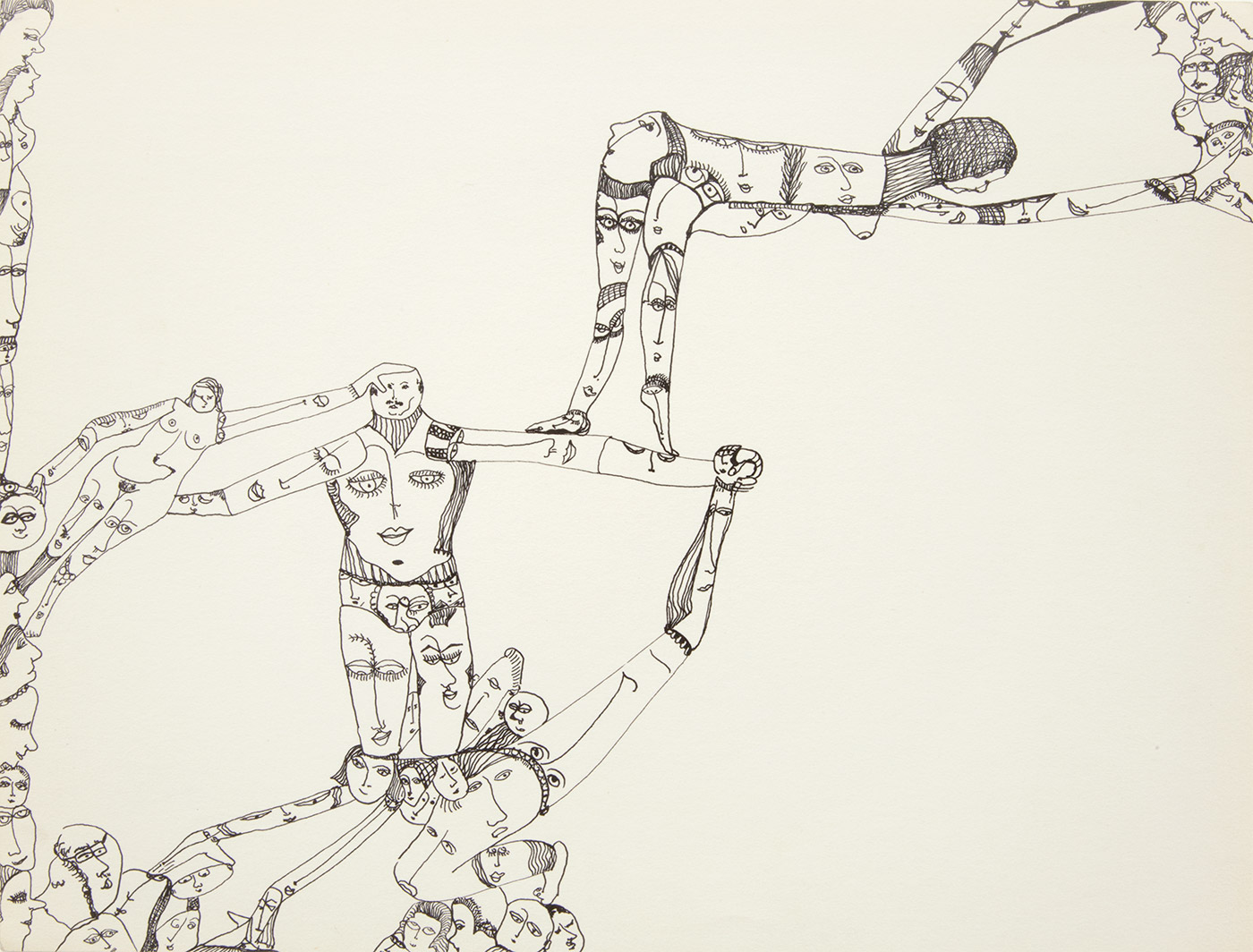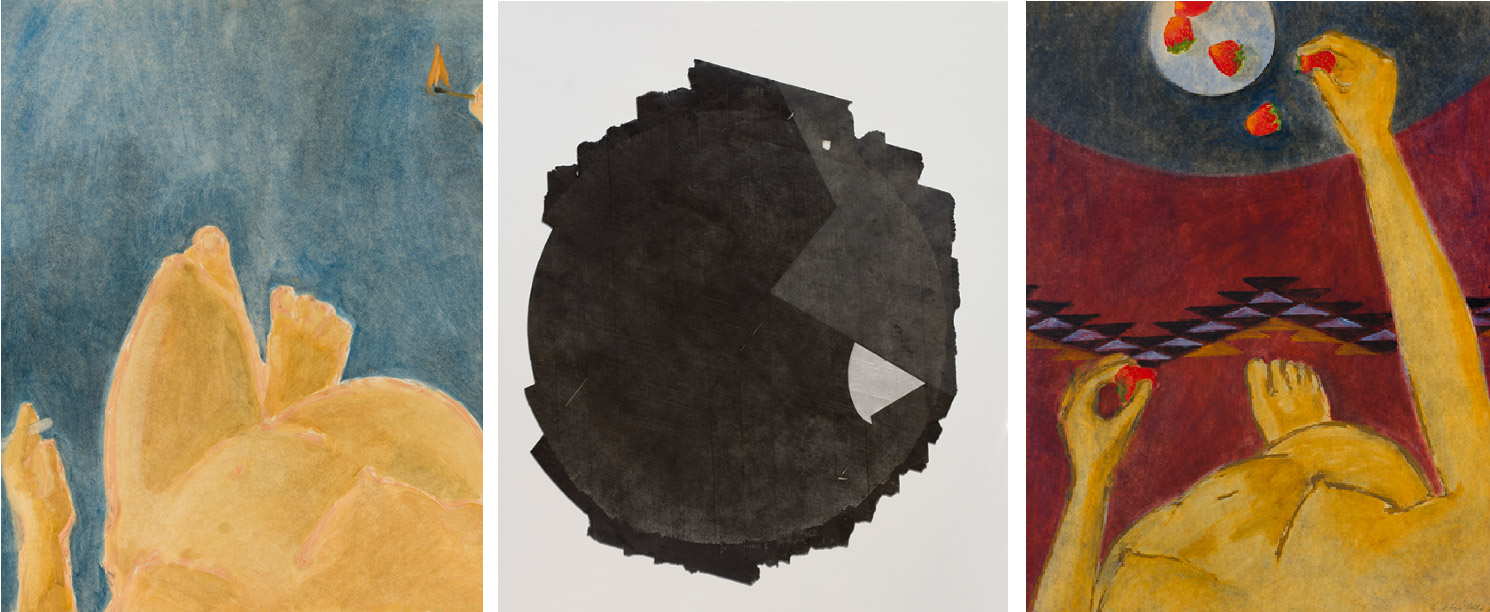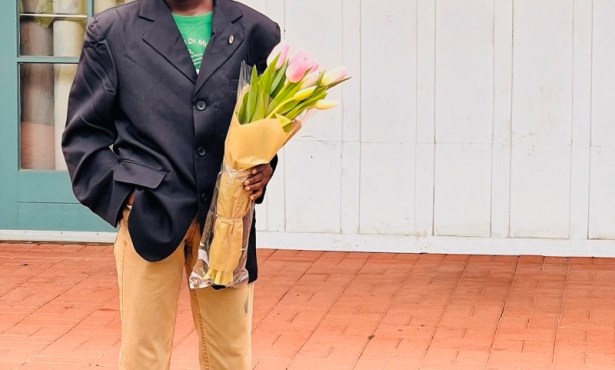‘Summer Nocturne’ at SBMA
Paper Hits of the 1970s

Routinely slandered as the airhead middle child between the radical 1960s and the greedy 1980s, the 1970s were a lot more than just a smiley face. In Summer Nocturne: Works on Paper from the 1970s, a group exhibit on view now through September 23 at the Santa Barbara Museum of Art (SBMA), the ’70s show up in all their complex glory, combining celebration with criticism and offering a lot to consider for the present moment. Fittingly for a time that mostly went its own way, curator Julie Joyce has imposed few rules. The 10 artists represented — Robert Beauchamp, Huguette Caland, Richard Dunlap, Dane Goodman, Luchita Hurtado, Tom Marioni, Marie Schoeff, Michelle Stuart, Joan Tanner, and John M. White — were all born outside of California, yet all spent at least some time living here. Several have settled permanently on the Central Coast, and some have been shown before at the museum, while others are making their SBMA debut.
The title for the show is taken from Dunlap’s 1977 construction “Summer Nocturne,” a giant black sun mandala, eight feet in diameter, that was created with tarpaper on the floor of the artist’s studio in Santa Barbara approximately 40 years ago. It’s an intensely evocative work that harnesses the macho energy of UCSB alum Richard Serra’s grease crayon “process” drawings to an image that’s emblematic of sunny Santa Barbara by negation. Nearby, negative space reappears in striking fashion through a large drawing on yellow paper that Marioni produced in the Santa Barbara Museum of Art as part of a live performance in 1979.
For “The Results of a Theatrical Action to Define Non-theatrical Principles,” the artist sat on a chair in bright light and used vigorous, rhythmic arm gestures to shade the area outside of his shadow with a large pencil. What’s left is a large rectangle of yellow paper hanging loose to the floor within which the figure of a seated man appears, his shape defined by the collection of strokes that surround the space his shadow once occupied. For Marioni, the founder of San Francisco’s Museum of Conceptual Art, these ’70s performances manifested the collective sense of Pacific Rim Zen that he felt bound the artists and poets of the Bay Area together. The show’s physical organization puts Marioni’s work in dialogue with Dunlap’s in a great conversation about the West Coast, art history, Northern and Southern California, and the influence of East Asia.

White, a similarly performance-oriented artist with connections to both San Francisco and greater Los Angeles, contributes “Golf Course Notations,” a series of drawings completed between 1975 and 1979 that depict various aspects of White’s mental process as he plays golf. An Otis graduate who participated in Yvonne Rainer’s experimental dance pieces in Los Angeles in 1969, White began his “notations” drawings in order to track the interactions of clients in a group therapy session he was running. These works, with their semi-legible inscriptions and loose, airy construction, suggest that golf is a metaphysical, as well as a physical, challenge.
Tanner’s “9 Spaces by 10” (1976) displays a related interest in mapping and hybridity, blending wire, beads, and insect wings in a grid to dazzling, subversive effect. Goodman also displays an affinity for the grid in his “Sunday Papers” (1975) series of 14 Albers-adjacent squares and one wooden pole. Unexpected connections abound, like the one between Stuart’s “#5 Moray Hill, NY” (1973) and Schoeff’s drawings of New York City’s Murray Street from 1979. The exquisite textures that Stuart explores through employing her frottage technique on bare ground reverberate both with the way that Schoeff draws attention to the physical interaction of paper and pigment in her drawings and with the strokes that define Marioni’s absence in his aforementioned work, which hangs on a nearby wall.
Caland, Hurtado, and Beauchamp all represent new attitudes toward portraiture and the body. For Hurtado, that means nude self-portraits drawn from eccentric points of view, such as looking straight down. These mesmerizing images seemingly belong as much to the aesthetic of video and photography as to any existing tradition of draftsmanship. Beauchamp and Caland conjure social reality through distortions of the figure, successfully predicting a whole school of later work that includes genre-smashing artists like Grayson Perry, Cecily Brown, and Dasha Shishkin.
For curator Joyce, the impulse for the show came in part through a coincidence. After researching all the important contemporary art exhibitions staged by the museum for a recent anniversary volume of SBMA history, she knew that Dunlap had done a major solo installation and performance piece at the museum in the 1970s. “Summer Nocturne,” however, was stored in a part of the vault that was completely inaccessible until work began on the museum’s renovation. One day, as items were being removed from the newly accessible vault area, Joyce saw this giant work go by in its storage container. Putting it on display this summer embodies a strategy that the museum has been employing for some time in regard to living area artists. As Joyce put it, “Artists who happen to be local, if and when we show them, we try to provide a context that puts them on the same stage as artists from elsewhere.” Goodman, for example, came to live in Santa Barbara from Sacramento by way of New York City, and created “Sunday Papers” in dialogue with the hard edges and straight lines of minimalism. Critical of the uniformity he sensed in otherwise inspiring figures such as Josef Albers and Ad Reinhardt, Goodman made his series of squares appear regular at a distance, only to reveal nuance and complexity in the layering of different colors and the attention lavished on the blurs and blends occurring at the shapes’ edges upon closer inspection.
Schoeff, who was living in downtown New York in the late 1970s, and coincidentally meeting and marrying Goodman at that time, sees the grease pencil drawings by which she is represented in the show in relation to photography. “Like a souvenir,” said Schoeff, “it’s the attempt to do something impossible, to freeze a moment.” For all these artists, the challenge of the period, regardless of one’s approach, was to find a subject matter and a way of handling it that was purely one’s own.
One unspoken aspect of the exhibition’s appeal is that it represents a time when the artists involved were first discovering the range of possibilities available to them in the newly expanded field of artistic expression. The museum’s education program has set out to recapture this excitement in two ways. First, they have invited the Grammy-winning composer and jazz musician Ted Nash to take up residence in July and to conduct a pair of workshops, one for musicians that will lead to a public concert on July 7, and another for teens to explore multimedia collaborations that will result in a performance on July 12. And then, on Thursday, August 16, critic and musician Josef Woodard will moderate a panel discussion featuring Richard Dunlap and Joan Tanner talking about “The Santa Barbara Art Scene in the ’70s” at 5:30 p.m. in the museum’s Mary Craig Auditorium. By at once looking forward and looking back, Summer Nocturne explores the ongoing creative energy of Santa Barbara in the 1970s.



